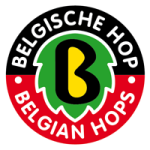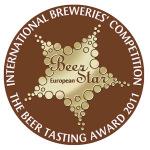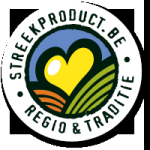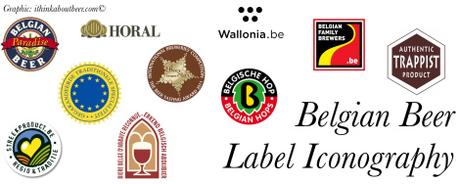 Belgian Beer Label Iconography
Belgian Beer Label Iconography
In Part 1 Belgian Beer Label Iconography, we looked at 4 of the logos that appear on Belgian beer label, in the next section we’ll look over the rest of the common logos that represent the various associations or awards in the Belgian and European brewing community.

Founded in 1997 to protect the integrity of the Trappist name and to prevent its secular commercialization, the International Trappist Association has one of the most recognizable logos in the international brewing world. What most beer fans don’t know is that it isn’t just for beers brewed at Trappist monasteries, but any product made at a member Trappist monastery that meets the rules of the ITA.
The rules that govern the legally protected rights to use the label are:
- The beer must be brewed within the walls of a Trappist monastery and be brewed by or have the brewing be supervised by the Monks.
- The brewery must be of secondary importance and be subject to business practices commensurate with that of a monastic life.
- The brewery isn’t for making profits. The money is to be used to pay for the upkeep of the monastery and its monks. Any excess money is to be used for the monastery’s charitable ventures.
- The quality of the beers are subject to quality monitoring.
Like the GTS label, the ITA label isn’t exclusive to Belgium, although 6 of 11 Trappist breweries are in Belgium. Indeed, they were the driving force behind the creation of the ITA. You can find the ITA hexagon on beers, cakes, soaps, liquors, and any number of other Trappist crafted goods. When you see the logo and buy the product, you know your money is going to a hand crafted product whose proceeds go to support the upkeep, livelihood, and charities of the monks and nuns of the Trappist world.
Belgium’s Trappist breweries are Achel, Chimay, Orval, Rochefort, Westmalle, are Westvleteren. The other 5 breweries are La Trappe (Netherlands), Spencer (USA), Stift Engelszell (Austria), Tre Fontane (Italy), and Zundert (Netherlands). There are several other Trappist abbeys that use the logo on non-beer products. You can get a complete list of the associated abbeys at the link above.
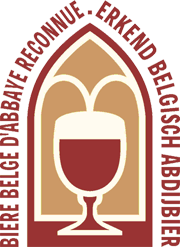
There are a lot of beers that use the word “Abbey” in their title (Abdij in Flemish or Abbaye in French). Some names are purely for marketing while others have a history. How can you tell the difference? Fortunately for beer fans, the Belgian Brewers Union (BBU) maintains and certifies official abbey beers. This logo was created by the BBU to provide consumers with a base level of information about the provenance of the beer they’re buying. To be able to use the logo, the brewery must be members of the BBU and follows the rules assigned to this mark. The mark was instituted in 1999, so there are two sets of rules: one for beers preceding the date and one for after.
Rules for beers existing prior to 1999 Mark:
- There needs to be a connection to an existing or defunct abbey
- Royalties need to be paid to the abbey or an allied organization if it is no longer functioning to be used for charitable works, including the upkeep of the abbey and its cultural works.
- The marketing
Belgian Hops is the trade group that represents Belgian’s hop industry, which is made up entirely of small family operations. On beer labels, the Belgian Hop logo is used to signify a beer that’s brewed with at least 50% Belgian hops. The amount of hops grown in Belgium has steadily declined as more farmers give up the business. Currently there are 15 family hop farmers. The logo and hops association is intended to bring notice to beer drinkers about the hops in their Belgian beer. It’s designed to help Belgium’s dwindling hop farmers thrive.
Much like the Belgian Family Brewers logo, not every beer a brewery makes will carry the Belgian Hops logo. Only those that have a hop content above the required 50% can use the logo. Some of the more famous examples include: St Bernardus ABT 12, De Plukker Keikoppen, De Struise Pannepot, De Ranke XX, Vapeur Saison de Pipaix, Gouden Carolus Cuvee van de Keizer, and Kasteel Triple. You can find a more complete list on the association’s direction on their website (linked above).
The European Beer Star is one of the largest beer competitions in the world. Organized by a group of small, independent breweries and German private brewery associations. In its 15th year, it received over 1,600 beer submissions from 42 countries. The tasting focuses on the styles of beer that originated in Europe and their traditional flavor profile. The judging is done blindly by a panel of brewmasters, Beer Sommeliers, beer experts, and journalists from around the world. Breweries who win at the Beer Star proudly adorn the winning beer label with their medal.
Streekproduct.be is a regional label that is applied to Flemish made products (Flanders is the northern Dutch speaking portion of Belgium). It functions similarly to the EU labels that signify a quality, regional, and traditional product. This logo was created to promote products that are uniquely Flemish both within Flanders borders and to its export markets.
Wallonia is the southern French-speaking region of Belgium. Unlike the northern Flemish region, Wallonia is predominantly rural and far more rustic than more fast-paced and modern north. It’s also farm more economically depressed. Wallonia’s past wealth was based on the old heavy industries of coal and steel. To promote itself and attract investment, the Walloon government has created a logo and brand to stimulate development and promote Wallonia as a dynamic region with fine products and heritage worth supporting and investing in.
Now, hopefully, you’ll understand what’s happening on the label of your Belgian beer just a bit better. Knowing the story of who is brewing your beer and the heritage they’re bringing to their craft won’t make the beer taste any better or worse, but it will give you a deeper appreciation of all that has gone into the beer in your glass.
